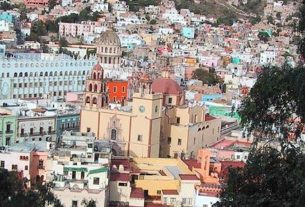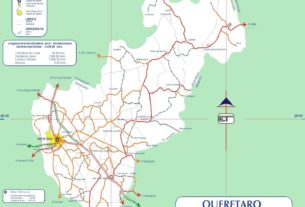Mythology and Legends of the Nahua People:
Essays on Ancient Mexico
- Part 1: “The Creation of the Universe”
- Part 2: “Legend of the Fifth Sun”
- Part 3: “Creation of the Fifth Sun at Teotihuacan”
As the future unfolds, history is tucked away into the past. We see this past because our ancestors recorded the events of their lives by writing them down in some form or another, be it with chisel, quill or pen. What we know about history, or rather what we think we know is dependent on who wrote those histories and what they chose to include. Going further and further back in time there is less and less information, until one reaches a period of time before the written word, approximately 5000 years ago.
The earliest written history in the New World is in the form of Codices, pictographic records that the Ancient Americans used to record their lives. A codex was an extremely long piece of hand-pressed paper, folded like an accordion and bound by a thin piece of wood. When unfolded, brightly painted images of gods and warrior kings tell of heroic events and the people’s long and detailed ancestries.
Upon their arrival in the New World in the sixteenth century, the first Spaniards destroyed countless ancient texts of the native people. But with the arrival of the Franciscan friars came scholarly intrigue and most of all the desire to know more about these individuals who were to be Christianized. In an attempt to recover the lost knowledge, one man in particular, Franciscan friar Bernardino de Sahagún gathered together orators and scribes and set out to re-record the ancient past of Mexico. Much of our present knowledge of the Ancient Mexicans comes from his endeavors.
Before written history there was oral tradition: legends and song that strove to keep the past in the present. Because there were many individuals who wrote or told these legends, it is not uncommon that numerous versions describe the same event.
The codices are written history, but their content is based on legend, story and song. In the history of ancient Mexico, legend and fact have become intertwined as historical figures turned legendary heroes fight against the almighty gods.
The Creation of the Universe
In the beginning there was nothing; nothing at all. No light, no life, no consciousness, no movement, no breath. In the beginning of time and in the Void the Oldest of Old Gods, Ometeotl, was formed.
It is the nature of things that Ometeotl, Creator of the Universe, was both masculine and feminine. This is why the Supreme First God was able to create himself-herself, because he-she could bear life alone. And so it was that the Oldest of Old Gods began the Creation in the dark emptiness that was nothing.
Ometeotl was the first existence to be. This Oldest of Old Gods was therefore, everything that was. When everything exists in one being, all opposites unite. The Creator is both generator of chaos and giver of harmony and order. Ometeotl is both spirit and matter, fire and water, black and white, stillness and movement, life and death, creator and destroyer, and the embodiment of good and evil. Because of this, the Oldest of Old Gods is called the God of Duality, and is the divinity where opposites converge in a supreme manifestation of The All.
In the nothingness of the Void, Ometeotl, The First God, created himself-herself, thought himself-herself up, invented himself-herself, in order to initiate The Beginning, and thus generate all that would exist thereafter. Giver of life and the one who takes it away, the Oldest God both creates and destroys in order to generate Ollin, the sacred movement in continuum, which gives impulse to our world.
Once created, the Supreme God Ometeotl, being both masculine and feminine, spawned four children who became the ministers of the Genesis and the creation of our visible, palpable, physical and changing world. These children are separate, yet the same, and for this reason they are referred to as the four manifestations of one god, Tezcatlipoca, God of the Smoking Mirror.
The four Tezcatlipocas created our world. They then created the gods destined to the preservation of this world, the sustaining of all natural phenomena, and the unchaining of the life forms. These four gods, children of Ometeotl, have ever since served as the guardians of humans, as those who administer both awards and punishment, and as our guides.
Our ancestors tell us that once they were born, the four Tezcatlipocas existed for six hundred years. It was only after this period that they began their task of The Creation: They created water, the god Tlaloc and his goddess, who together embodied the essence of water. Then the Tezcatlipocas created Cipactli.
Cipactli is a dragon-serpent that floats in the void of nothingness. Beyond Cipactli’s monster body nothing exists. Our large and ever extending universe and all the other universes beyond are contained within Cipactli.
In Cipactli’s great body the gods gave form to our world. Thirteen heavens exist in Cipactli’s head, the earth is in the middle, and nine underworlds go down the length of Cipactli’s tail. Cipactli is so enormous that it is almost impossible to imagine. Our entire existence fits inside. The earth is a great, flat disc located in the middle of Cipactli’s body and is surrounded by the Celestial Waters, making our world Cem-á-nahuac: that which is surrounded by water.
It is understandable that the ancient mind reasoned thus; if one turns east from the heart of these lands, toward the rising sun, and walks and walks to the ends of the earth, one reaches water. And if one turns south, beyond the path of the sun, and walks and walks to the ends of the earth, his or her journey ends at water. In the house of the setting sun, in the west, there is also water. Even in the farthest regions of the north one will eventually reach a great mass of ice. But the sun battles with the ice, turning it into water. Thus, the ancient mind knew our world as a flat, round disc surrounded by water because their ancestors walked all throughout, and found it so. This is what legend tells us. This is their truth.
The world is divided into four great quadrants. At the very center is the navel. Magical things happen at the earth’s navel. From this center Ometeotl sends forth his-her powerful energy and controls the cosmos and things to come. And from this navel the four quadrants of the earth extend all the way to the horizons, the heavens, and the surrounding celestial sea. Each of the four regions has different characteristics, as each is distinct in its relation to the passage of the sun.
At the end of the earth where the sun sets, the West, is the sun’s home. This is the region of the White Tezcatlipoca, who is also known as Quetzalcoatl, keeper of wisdom and things related to maize. It is the land of experience, wisdom, old age, light, fertility and life. Quetzalcoatl rules this land and is characterized by these qualities. Opposite the region of the setting sun is the East, the land of the Red Tezcatlipoca, who is also known as Xipe-Totec. If one were to ever reach there, and it is doubtful because it lay at the ends of the earth beyond many perils indeed, one would find the region dominated by springtime and rebirth. In the East the seasons are forever changing, the leaves of trees constantly falling, and buds are continually sprouting forth with new life.
The area to the left of the setting sun is the land of the Blue Tezcatlipoca, the God That is Eaten, known as Tonatiuh, the Sun. This god is the God That is Eaten because day after day the Sun descends to the Underworld and falls into the shadows of darkness, while the moon and the stars reign.
Fighting against the Night, Tonatiuh is weakened and loses energy. But the nutrients of the blood of life spilled in penitence help fortify the Sun to win the battle against the Night. Each dawn it emerges from the Underworld and at this moment becomes the Eagle of Fire Bolts, a symbol of victory against the treacherous Night. The land at the end of the earth to the left of the setting sun is associated with the color blue because the trajectory of Tonatiuh is a great circular path along the great celestial dome.
The region to the right of the setting sun, the North, is the sacred place of the Black Tezcatlipoca, the Lord of the Night Sky. The god Mictlantecuhtli reigns there. This is the bitter cold and fleshless Land of the Dead. It is said that when one dies, one goes there; one goes directly there, and from that land do the dead set out.
And so, the four Tezcatlipocas, sons of Ometeotl, created the four regions of the world in the middle of Cipactli’s great monster body. Above our world, Cem-á-nahuac, they then created the heavens that surround our world. These heavens are like a great blue dome of different levels in which the heavenly bodies move. In the five lowest heavens are the paths of the moon, the stars, the sun, Venus, and the comets. They are covered by the heaven in which the Night extends itself, then the heaven of blue. Beyond is the heaven where Tlaloc dominates the Rain and the crashing of the Obsidian Swords. Just below the highest heaven is the most divine region of the all the gods. But above all other heavens, is Omeyocán, the place of duality, and dwelling place of the supreme deity, generator and founder of the universe, Ometeotl. The Creator of All is alone in the highest heaven.
After the four Tezcatlipocas created the earth and heavens they then formed the nine strata of the Underworld, known as Mictlán. These nine hells are located in the tail of Cipactli; the dragon-serpent that makes up our universe in the Void. In the Underworld the dead journey for four years through the nine levels, during which time they face perilous tests and dangers. If they overcome these challenges, only then do their souls find rest.
Upon dying, humans travel to the Region of the Dead where the Black Tezcatlipoca releases them for their journey through the Underworld. In the first level they encounter a place below the earth where they find themselves at the edge of a treacherous river. In order to cross the river they need the help of a dog, one that is dedicated to do just this. If they pass the river, they descend to the next level, to the place where the mountains crash. The dead must cross the moving and shaking mountains quickly so as not to remain trapped as prisoners for eternity.
In this manner the dead pass through the trials of Mictlán until they come to the lowest level and face the last obstacle, the extension of the Nine Waters. If overcome, they reach the region of rest, and their soul is liberated of corporal suffering.
In this way the four Tezcatilpocas created the four regions of the earth, the celestial waters, heaven and hell. The creation of the universe changes with time and culture. This was the knowledge of our ancestors, a colorful canvas that paints the history of our world, brought down to us through poetry, legend and song. This is our heritage, the truths of our ancestors, and to some degree that which has made us what we are today.



